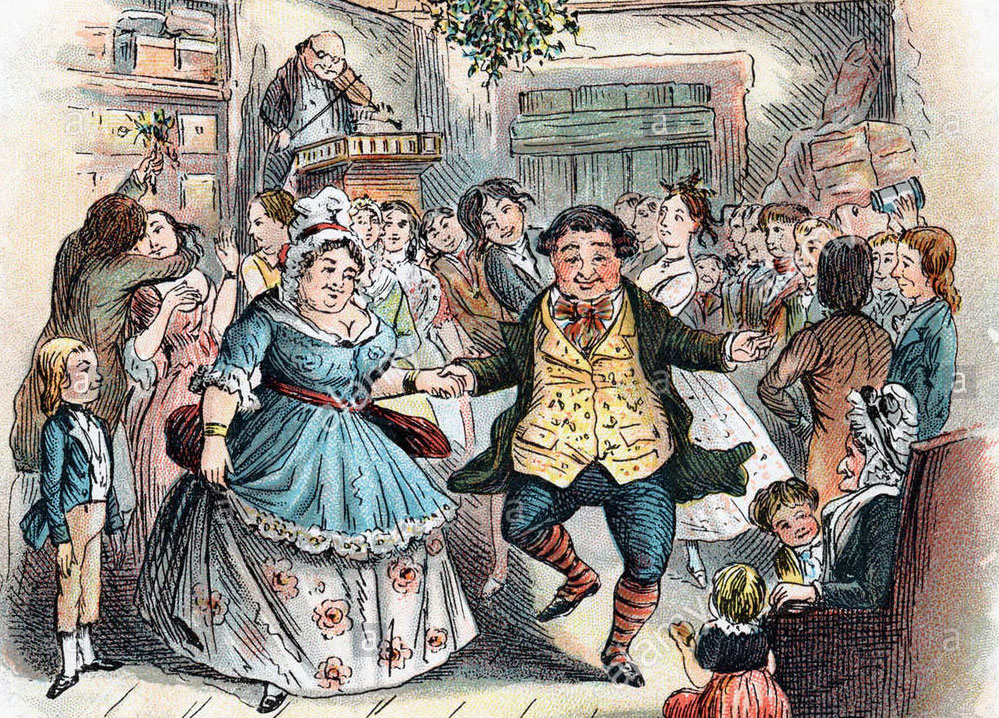
“Is Christmas too materialistic? Well, it’s not as materialistic as God becoming flesh, redeeming our sinful flesh, and sending us back into the material world to live out our faith in love and service to our physical neighbors.” –Gene Veith
We are routinely told that Charles Dickens’ beloved story, A Christmas Carol, was instrumental in giving us Christmas as we know it — marking the holiday not just as a moment of reflection on Christ’s birth, but as a secular celebration of common virtues and sentiments.
Such is the argument, for example, in the book, The Man Who Invented Christmas, recently adapted into a well-regarded film, which notes the real historical shift in certain traditions and customs that came thereafter. Patrick Callahan makes a similar case in his essay, “Charles Dickens’ War on Christmas,” though with far less admiration, asking, “How long can Christmas seem to serve both God and Mammon?”
But while Dickens surely had a transformative effect on our basic framework for celebration — our customs, feasts, vocabulary, and imaginations — are the “secular” features of Dickens’ story all that distant or detached from the sacred?
As Gene Veith reminds us, the doctrine of vocation allows us to indulge a much richer, integrative vision. “The realm of ‘Christian’ does not consist just of overtly devout exercises,” he writes. “Rather, it also includes our lives in the family, the workplace, and the community.” To whatever extent we hem and haw at certain “secular” or “external” features that now complement modern celebrations — from Christmas trees to gift-giving to commercialization — we “may be missing something about the scope of Christ’s reign and the nature of vocation.”
It’s a tension familiar to Veith, who has dedicated much of his work to the subject. “The doctrine of vocation is liberating,” he writes in his book, Working for Our Neighbor, Acton’s Lutheran primer on faith, work, and economics. “Once you have grasped it, you will feel as the blind man who was healed by our Lord, seeing for the first time in his life. All of your life is a wonderful journey of service to your loving God.”
That journey includes the “secular” components of Dickens’ tale, which wield their own liberating effects not only on Christmas tradition, but on our economic imaginations in everyday life:
The Christmas Carol is about vocation. Scrooge has to learn to love and serve his neighbors, which is the purpose of all vocations. As an employer, he has to learn to see employees like Bob Cratchitt as human beings with families and with struggles, to love them and then to serve them, even as they serve him in their work. Scrooge has to learn to love and serve his family, including his earnest nephew and his bride. He has to learn to love and serve his neighbors in the London alleys who are poor and destitute. He has to learn to love and serve the urchins in the street and the passersby in the square.
The catalyst for this archetype of self-seeking capitalism discovering the true purpose of his vocations in the family, the workplace, and the community is the spirit(s) of Christmas.
Indeed, setting aside the more excessive frivolities and anxieties that too often accompany the Christmas season, many of these same lessons apply to our current context across the economic and social orders.
So what are the takeaways for the Christian in what at first appears to be a secular tale? Veith makes some helpful connections between the more common holiday tropes and traditions and a Christian understanding of vocation.
“Christmas is a time for family.” Our vocations in the family.
“Christmas is for kids.” Family vocation + homage to the Christchild.
Office parties. Our economic vocations.
Shopping. Our economic activities as part of the exchange of vocation. Whereas usually, our economic activities pursue our rational self-interests, our Christmas shopping makes us think about the interests of the neighbor we are shopping for.
Gifts. Giving and receiving gifts is the image both of the grace of God in Christ and the mutual giving and receiving that takes place in every vocation.
Dickens’ story reminds us that our celebrations of Christ’s birth ought to stretch into all that we do — not just the traditions within the walls of our churches or the contexts of our calendars, and not just through our charity and volunteer activities therefrom.
It ought to reach into our everyday loving and lifting in our families, in our workplaces, in our educational and cultural institutions, in our artistic activity and creative enterprise, and in our political action and witness.
“All our work in this world is made of stuff of the earth,” says Evan Koons in For the Life of the World, “all of it takes place here below, but all of it is pointed toward heaven. All of it is in a sense holy. Imagine if all of us offered our work for the good of the cities around us. How might we be able to change those cities? What would it look like if we only understood that our humble work is a heavenward offering? What would our city of exile look like then?”
The gift that came at Christmas reunites the divine generosity of the Father with the hungry world that surrounds us. It bridges the spiritual and the material. The gift has already been given. As we receive it, we have the pleasure of celebrating it in all that we do, a lesson that Dickens taught us well.

